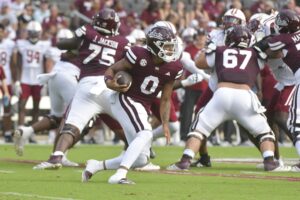One of sports’ great rivalries resumes in Philadelphia on Saturday as Army plays Navy for the 119th time. The annual Army-Navy game stands alone among the great rivalries for many reasons.
There’s history–four national championships and five Heisman Trophy winners between the two schools. There’s the pageantry of the in-game experience, with two full student bodies marching into the stadium and dignitaries galore. And, of course, there’s the meaning. Student-athletes that harken back to the roots of college football and the reality of what awaits each player when his football days are over.
Army-Navy 2018: Looking Forward, Not Backwards
Too often, however, fans think of this rivalry in the past tense. The term “Army-Navy Rivalry” conjures up mental images of leather clad helmets and dusty fields.
It’s time for fans–and the programs–to look to the future not into the past.
Much of that responsibility is on the teams. From 1941 to 1963, at least one team was ranked in the Top 25 in 15 of those contests. In five of those contests, both teams were ranked. Twice during that span, the Army-Navy game was a matchup of one versus two.
Better Teams, Better Rivalry
This weekend will be just the fourth time since 1963 that one team will enter with a major outlet ranking. For Army-Navy to continue to be relevant, the product on the field must be a quality football game.
The programs are getting better. Navy qualified for a bowl in 14 of the previous 15 seasons. And while the Midshipmen won’t be playing in a bowl this season, they’ve clearly been the better of the two teams over the past decade.
Army, meanwhile, found their man in Jeff Monken. His Black Knights will play in their fourth straight bowl this year. And a win against Navy or in the bowl game will give Army a second straight ten win season. The five coaches over the previous 13 years to Monken’s hiring are all in the bottom six of Army’s all-time winning percentage for coaches. That’s how rotted the program was before Monken took over.
Better Program, Better Teams
There’s more to making a better team at Army and Navy, however. With all due respect to the hard working student-athletes on other college football teams, there are unique demands on the cadets and midshipmen that play football at Army and Navy. The institutions also look back, and for good reason.
Both Monken and Navy head coach Ken Niumatalolo have found innovative ways to improve their programs within incredibly tight institutional restraints. Leaders at both academies had to be convinced that bettering the programs wouldn’t jeopardize the institutions’ primary missions of preparing future leaders for a lifetime of service for the common defense. Both men seem to have found a home at each school. Niumatalolo was rumored as a candidate for the BYU job in late December, 2015. That commitment to the institutions will help the leaders at Army and Navy commit more to the coaches’ visions on building their programs. Rather than looking back, both coaches have focused on moving their programs forward. Both, fortunately, found success.
(Triple) Options
The game doesn’t stand still, however. With improved teams and improved programs come more decisions.
For Army, that means keeping Monken in place. With a flexbone offensive scheme, there’s only so many places that would be interested in Monken. Their most important decisions moving forward centers around conference alignment. They are currently one of only six independents in the Football Bowl Subdivision (FBS). The evolution of college football favors those teams in conferences.
Without a doubt, Army’s ceiling is limited being an independent. We’re just two years removed from Navy vying for the Group of Five birth in the New Year’s Six bowls. But conference alignment will come at a cost, as well. Army’s schedule didn’t impress the College Football Playoff committee this year. Even with nine wins, they couldn’t crack the CFP Top 25.
The Military Academy needs to decide if an 8-10 win season with no hopes of cracking the big time is better than a tougher road to hoe with a conference schedule, albeit with better hopes and the promise of more guaranteed money.
Navy made many of these decisions a decade ago. They’ve got their coach. And they seem to be comfortable in the American Athletic Conference, finishing up their fourth season in the AAC. But with built-in, yearly rivalries with Army, Air Force, and Notre Dame, Navy only has one open space for scheduling every year. That severely hamstrings an athletic director.
Location, Location, Location
Here’s one area where the schools should work together. The rivalry is in a good place right now. It has an exclusive national television spotlight. Both teams are competitive and nationally relevant. And both teams have a national fan base. There’s an opportunity to move the game to different locations to drive increased exposure. Notre Dame does this effectively with their Shamrock Series.
Army-Navy will be in Philadelphia for 2019 and 2020, and MetLife Stadium in New Jersey in 2021. Army and Navy should work now to secure a national rotation of venues over the next decade. Chicago, The Rose Bowl, Baltimore and Washington, D.C. all have historical significance in the rivalry. But the game should expand to new markets as well. Atlanta, Dallas, Seattle, and New Orleans would all be great places to take the most unique rivalry in college football. In all of sports for that matter.
The Actual Game
Army brings the second best rushing attack in the nation into the game, along with a modest two-game winning streak in the series. The Black Knights are favored, as they have executed far better this season. But the big difference is the Army defense.
Navy, however, has their backs against he wall. An injury-plagued season has left the Midshipmen bowl-less for the first time since 2011. That means this game is all they have left. That’s a dangerous proposition in a rivalry that means so much to so many.
The game has been decided by 16 points total over the last four seasons. Don’t expect anything different this year. Forget the difference in records. Throw out the statistics. And pay no attention to the injuries.
In a game that means this much, to so many, and has for so long, no one is looking back to the season that was.
They’re only looking ahead to the game that is.
Main Photo:
Embed from Getty Images






